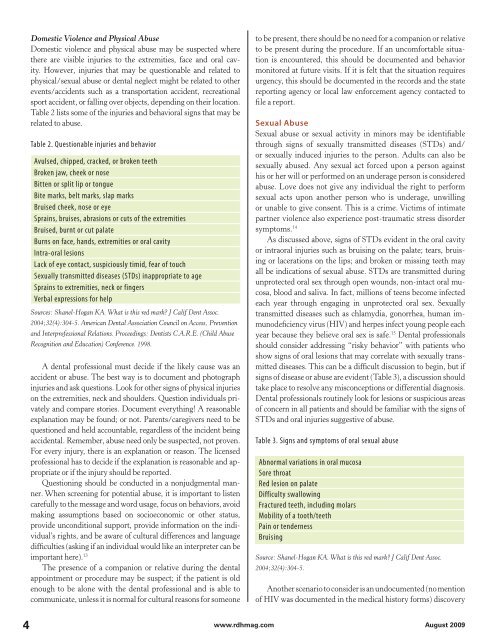Abuse: Mandated Reporting for Dental Professionals - IneedCE.com
Abuse: Mandated Reporting for Dental Professionals - IneedCE.com
Abuse: Mandated Reporting for Dental Professionals - IneedCE.com
Create successful ePaper yourself
Turn your PDF publications into a flip-book with our unique Google optimized e-Paper software.
Domestic Violence and Physical <strong>Abuse</strong><br />
Domestic violence and physical abuse may be suspected where<br />
there are visible injuries to the extremities, face and oral cavity.<br />
However, injuries that may be questionable and related to<br />
physical/sexual abuse or dental neglect might be related to other<br />
events/accidents such as a transportation accident, recreational<br />
sport accident, or falling over objects, depending on their location.<br />
Table 2 lists some of the injuries and behavioral signs that may be<br />
related to abuse.<br />
Table 2. Questionable injuries and behavior<br />
Avulsed, chipped, cracked, or broken teeth<br />
Broken jaw, cheek or nose<br />
Bitten or split lip or tongue<br />
Bite marks, belt marks, slap marks<br />
Bruised cheek, nose or eye<br />
Sprains, bruises, abrasions or cuts of the extremities<br />
Bruised, burnt or cut palate<br />
Burns on face, hands, extremities or oral cavity<br />
Intra-oral lesions<br />
Lack of eye contact, suspiciously timid, fear of touch<br />
Sexually transmitted diseases (STDs) inappropriate to age<br />
Sprains to extremities, neck or fingers<br />
Verbal expressions <strong>for</strong> help<br />
Sources: Shanel-Hogan KA. What is this red mark? J Calif Dent Assoc.<br />
2004;32(4):304-5. American <strong>Dental</strong> Association Council on Access, Prevention<br />
and Interprofessional Relations. Proceedings: Dentists C.A.R.E. (Child <strong>Abuse</strong><br />
Recognition and Education) Conference. 1998.<br />
A dental professional must decide if the likely cause was an<br />
accident or abuse. The best way is to document and photograph<br />
injuries and ask questions. Look <strong>for</strong> other signs of physical injuries<br />
on the extremities, neck and shoulders. Question individuals privately<br />
and <strong>com</strong>pare stories. Document everything! A reasonable<br />
explanation may be found; or not. Parents/caregivers need to be<br />
questioned and held accountable, regardless of the incident being<br />
accidental. Remember, abuse need only be suspected, not proven.<br />
For every injury, there is an explanation or reason. The licensed<br />
professional has to decide if the explanation is reasonable and appropriate<br />
or if the injury should be reported.<br />
Questioning should be conducted in a nonjudgmental manner.<br />
When screening <strong>for</strong> potential abuse, it is important to listen<br />
carefully to the message and word usage, focus on behaviors, avoid<br />
making assumptions based on socioeconomic or other status,<br />
provide unconditional support, provide in<strong>for</strong>mation on the individual’s<br />
rights, and be aware of cultural differences and language<br />
difficulties (asking if an individual would like an interpreter can be<br />
important here). 13<br />
The presence of a <strong>com</strong>panion or relative during the dental<br />
appointment or procedure may be suspect; if the patient is old<br />
enough to be alone with the dental professional and is able to<br />
<strong>com</strong>municate, unless it is normal <strong>for</strong> cultural reasons <strong>for</strong> someone<br />
to be present, there should be no need <strong>for</strong> a <strong>com</strong>panion or relative<br />
to be present during the procedure. If an un<strong>com</strong><strong>for</strong>table situation<br />
is encountered, this should be documented and behavior<br />
monitored at future visits. If it is felt that the situation requires<br />
urgency, this should be documented in the records and the state<br />
reporting agency or local law en<strong>for</strong>cement agency contacted to<br />
file a report.<br />
Sexual <strong>Abuse</strong><br />
Sexual abuse or sexual activity in minors may be identifiable<br />
through signs of sexually transmitted diseases (STDs) and/<br />
or sexually induced injuries to the person. Adults can also be<br />
sexually abused. Any sexual act <strong>for</strong>ced upon a person against<br />
his or her will or per<strong>for</strong>med on an underage person is considered<br />
abuse. Love does not give any individual the right to per<strong>for</strong>m<br />
sexual acts upon another person who is underage, unwilling<br />
or unable to give consent. This is a crime. Victims of intimate<br />
partner violence also experience post-traumatic stress disorder<br />
symptoms. 14<br />
As discussed above, signs of STDs evident in the oral cavity<br />
or intraoral injuries such as bruising on the palate; tears, bruising<br />
or lacerations on the lips; and broken or missing teeth may<br />
all be indications of sexual abuse. STDs are transmitted during<br />
unprotected oral sex through open wounds, non-intact oral mucosa,<br />
blood and saliva. In fact, millions of teens be<strong>com</strong>e infected<br />
each year through engaging in unprotected oral sex. Sexually<br />
transmitted diseases such as chlamydia, gonorrhea, human immunodeficiency<br />
virus (HIV) and herpes infect young people each<br />
year because they believe oral sex is safe. 15 <strong>Dental</strong> professionals<br />
should consider addressing “risky behavior” with patients who<br />
show signs of oral lesions that may correlate with sexually transmitted<br />
diseases. This can be a difficult discussion to begin, but if<br />
signs of disease or abuse are evident (Table 3), a discussion should<br />
take place to resolve any misconceptions or differential diagnosis.<br />
<strong>Dental</strong> professionals routinely look <strong>for</strong> lesions or suspicious areas<br />
of concern in all patients and should be familiar with the signs of<br />
STDs and oral injuries suggestive of abuse.<br />
Table 3. Signs and symptoms of oral sexual abuse<br />
Abnormal variations in oral mucosa<br />
Sore throat<br />
Red lesion on palate<br />
Difficulty swallowing<br />
Fractured teeth, including molars<br />
Mobility of a tooth/teeth<br />
Pain or tenderness<br />
Bruising<br />
Source: Shanel-Hogan KA. What is this red mark? J Calif Dent Assoc.<br />
2004;32(4):304-5.<br />
Another scenario to consider is an undocumented (no mention<br />
of HIV was documented in the medical history <strong>for</strong>ms) discovery<br />
4 www.rdhmag.<strong>com</strong> August 2009
















